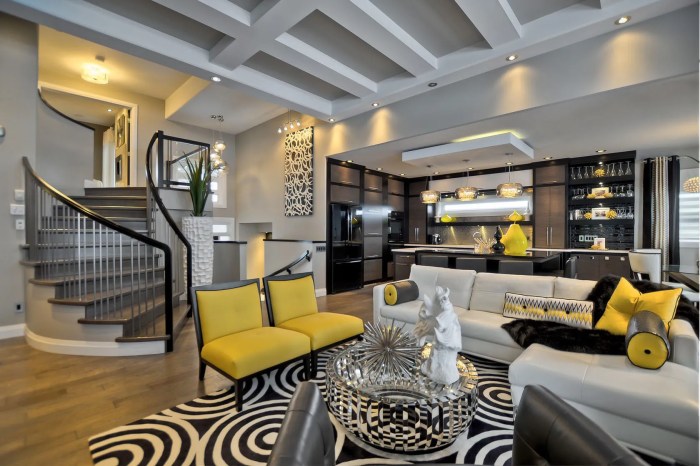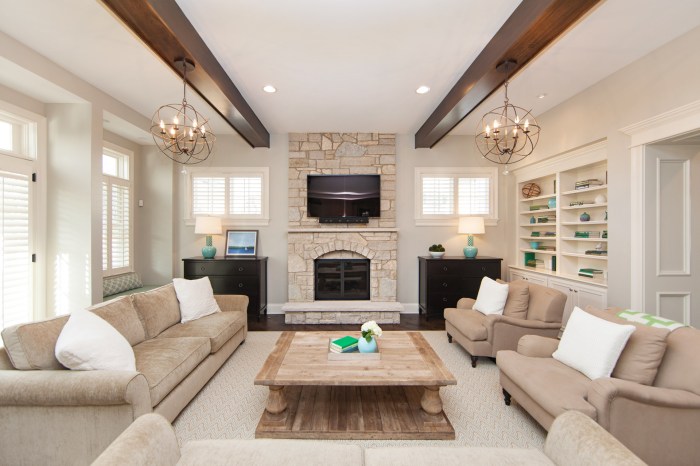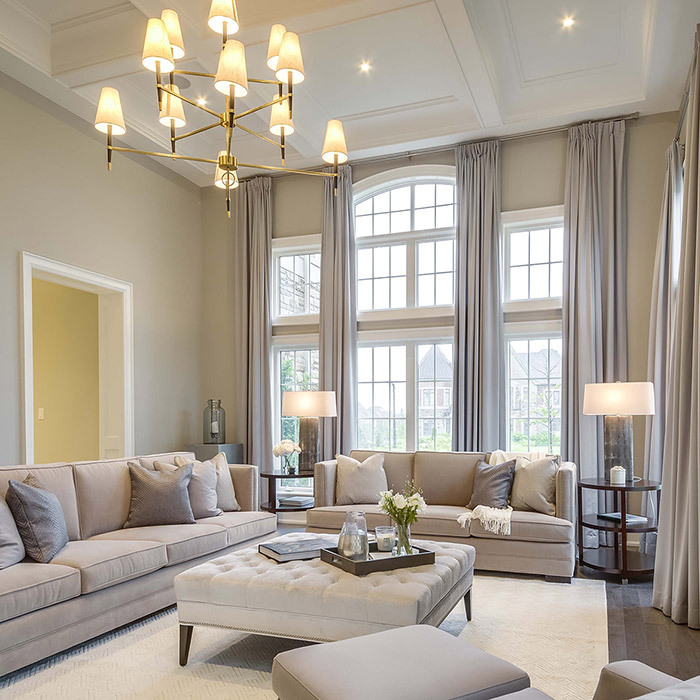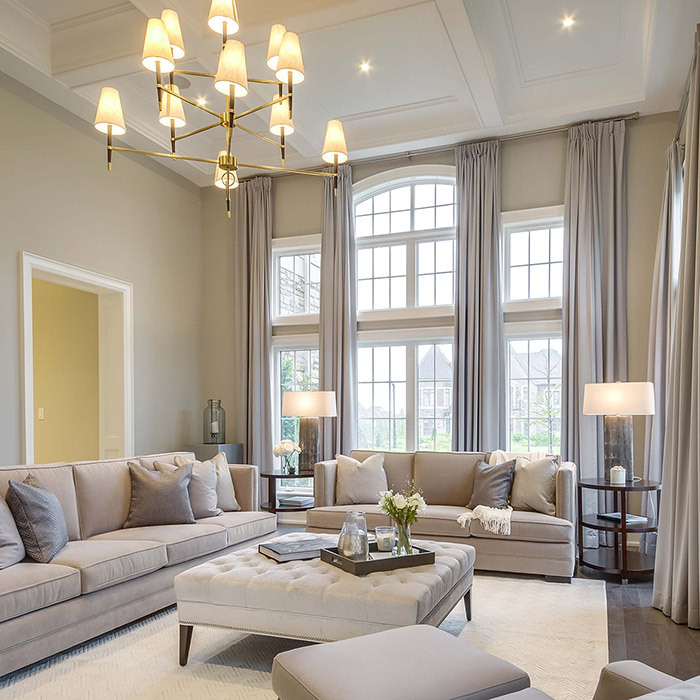Complete house interior design is more than just choosing furniture and paint colors. It’s about creating a space that reflects your personality, lifestyle, and needs, while ensuring every room flows seamlessly together. This comprehensive guide explores the multifaceted world of complete house interior design, offering practical tips and expert insights to transform your house into a truly beautiful and functional home.
From understanding the scope of complete house interior design and its key considerations to navigating the planning and design process, this guide will empower you to make informed decisions and achieve a cohesive and stylish outcome. We will delve into defining your design style, optimizing space planning, selecting the perfect color palette and materials, and choosing furniture that complements your vision.
Additionally, we’ll explore the importance of lighting, window treatments, decorative elements, and the essential aspects of budgeting and project management.
Planning and Design Process

The planning and design process for a complete house interior is a collaborative journey that transforms your vision into reality. It involves a series of well-defined stages, each contributing to the overall success of the project. This process ensures a seamless experience, from the initial concept to the final execution.
Initial Consultation and Needs Assessment
The initial consultation serves as the foundation for the entire design process. It’s a crucial step where we gather essential information about your preferences, lifestyle, and aspirations for your home. We delve into your specific needs, understand your budget constraints, and discuss your desired aesthetic.
This is where we establish a clear understanding of your vision and expectations.
- Discussion of Design Goals:We discuss your desired style, color palettes, and overall ambiance you envision for your home. This could range from modern minimalist to traditional elegance or anything in between.
- Lifestyle and Usage Patterns:We explore how you intend to use each space, considering the number of occupants, their ages, and any specific activities you enjoy. This helps us design functional and practical spaces.
- Budget and Timeline:We establish a clear understanding of your budget limitations and the desired timeline for the project. This ensures realistic planning and efficient resource allocation.
- Existing Conditions:We gather information about the existing layout, structural elements, and any limitations or challenges. This includes reviewing existing floor plans, taking measurements, and identifying potential obstacles.
Space Planning and Layout
Based on the information gathered during the initial consultation, we develop a comprehensive space planning and layout design. This involves creating a functional and aesthetically pleasing arrangement of furniture, fixtures, and appliances within each room.
This stage focuses on maximizing the use of available space while creating a harmonious flow between rooms.
- Floor Plan Development:We create detailed floor plans that incorporate your desired furniture placement, traffic flow, and functional zones. This provides a visual representation of the proposed layout.
- Furniture Selection and Placement:We select furniture pieces that complement the chosen style and ensure optimal comfort and functionality. We consider factors like scale, proportions, and ergonomics.
- Lighting Design:We plan the lighting scheme to enhance the overall ambiance and highlight specific features. This involves considering natural light sources, artificial lighting fixtures, and their placement.
- Material Selection:We explore various materials for flooring, walls, countertops, and other surfaces. We consider their durability, aesthetics, and budget implications.
Design Development and Presentation
This stage involves translating the initial concepts into detailed design drawings and presentations. We create mood boards, material samples, and 3D renderings to visualize the proposed design and communicate our vision effectively.
This allows you to see and experience the design before its actual implementation.
- Mood Boards and Material Samples:We create visual representations using images, fabric swatches, and material samples to showcase the proposed style, color palette, and textures.
- 3D Renderings and Virtual Tours:We utilize 3D modeling software to create realistic renderings and virtual tours that provide a comprehensive understanding of the design’s impact on the space.
- Design Presentation:We present the proposed design, including floor plans, elevations, and 3D visualizations, to you in a clear and concise manner. We discuss the design rationale, material choices, and any specific considerations.
Project Execution and Coordination, Complete house interior design
Once the design is finalized and approved, we move into the project execution phase. This involves coordinating with contractors, suppliers, and other professionals to ensure the successful implementation of the design.
This stage involves meticulous planning and communication to ensure a smooth and efficient execution process.
- Contractor Selection and Management:We assist you in selecting qualified contractors who can effectively execute the design plan. We manage communication and ensure adherence to the agreed-upon timeline and budget.
- Material Procurement and Delivery:We source and procure the necessary materials, fixtures, and furniture, ensuring they meet the specified quality and design requirements.
- Site Supervision and Quality Control:We oversee the construction and installation process, ensuring adherence to the design specifications and quality standards. We conduct regular site visits to monitor progress and address any potential issues.
- Project Completion and Handover:Once the project is complete, we conduct a final inspection and handover, ensuring everything meets the agreed-upon standards. We provide any necessary instructions and support for maintaining the newly designed space.
Essential Documents and Information
To ensure a smooth and successful design process, it’s crucial to have the following documents and information readily available:
- Floor Plans and Site Survey:Accurate floor plans of the existing space, including measurements, wall locations, and existing fixtures.
- Budget and Timeline:A clear Artikel of your budget constraints and the desired timeline for the project.
- Style Preferences:Inspiration images, mood boards, or examples of styles that resonate with you.
- Lifestyle and Usage Patterns:Detailed information about how you intend to use each space and the activities you enjoy.
- Existing Furniture and Appliances:A list of furniture and appliances you wish to keep, including their dimensions and condition.
Lighting Design: Complete House Interior Design

Lighting plays a crucial role in interior design, influencing the mood, ambiance, and functionality of a space. It can enhance architectural features, create visual interest, and highlight specific areas.
Designing a Lighting Plan
A well-designed lighting plan incorporates both natural and artificial light sources to create a harmonious and functional environment.
- Natural Light:Maximize natural light by using large windows, skylights, and light wells. Position furniture to take advantage of sunlight during the day.
- Artificial Light:Artificial light sources complement natural light and provide illumination when needed. Consider different types of artificial light, including:
- Ambient Lighting:Provides overall illumination for a space, often using ceiling fixtures or recessed lights.
- Task Lighting:Provides focused illumination for specific activities, such as reading, working, or cooking. Examples include desk lamps, under-cabinet lights, and pendant lights over kitchen islands.
- Accent Lighting:Highlights specific features, such as artwork, sculptures, or architectural details. Use track lighting, spotlights, or wall sconces for accent lighting.
Selecting Appropriate Lighting Fixtures
Choosing the right lighting fixtures is essential for achieving the desired mood and functionality.
- Consider the Room’s Function:Different areas of the house require different types of lighting. For example, a living room might need a combination of ambient and accent lighting, while a kitchen requires both ambient and task lighting.
- Choose the Right Style:Lighting fixtures should complement the overall design aesthetic of the space. For example, modern homes might feature sleek, minimalist fixtures, while traditional homes might prefer ornate chandeliers or sconces.
- Consider the Light Source:Different light sources produce different types of light, affecting the mood and ambiance of a space. Incandescent bulbs provide a warm, yellowish light, while fluorescent bulbs emit a cooler, whiter light. LED bulbs are energy-efficient and offer a wide range of color temperatures.
Complete house interior design encompasses every aspect of your home, from the grand entrance to the cozy nooks. When designing a multi-story home, the vertical space presents unique challenges and opportunities. A 3 story house interior design allows for a variety of layout possibilities, creating distinct zones for different functions while maintaining a cohesive aesthetic throughout the entire home.
Lighting for Different Areas
Here are some lighting suggestions for different areas of the house:
- Living Room:Combine ambient lighting from ceiling fixtures with accent lighting to highlight artwork or architectural features. Consider adding a floor lamp for reading or a dimmer switch to adjust the mood.
- Dining Room:A chandelier or pendant light over the dining table provides ambient lighting, while sconces on the walls can create a warm and inviting ambiance.
- Kitchen:Use a combination of ambient lighting from ceiling fixtures, task lighting under cabinets and over countertops, and accent lighting to highlight backsplashes or display areas.
- Bedroom:Create a relaxing atmosphere with soft, ambient lighting from bedside lamps or ceiling fixtures. Consider adding a dimmer switch to adjust the mood.
- Bathroom:Use bright, functional lighting over the vanity mirror for makeup application and grooming. Add ambient lighting from ceiling fixtures or sconces to create a spa-like ambiance.
Window Treatments and Accessories

Window treatments play a crucial role in enhancing the functionality and aesthetics of any interior space. They go beyond simply covering windows, offering a multifaceted approach to controlling light, providing privacy, and adding visual appeal.
Types of Window Treatments
Window treatments offer a wide range of options to suit different needs and design preferences. Each type has its own unique characteristics and benefits.
- Curtains: Curtains are fabric panels that hang from a rod or track, offering versatility in terms of style, fabric, and length. They can be sheer, opaque, or blackout, allowing for varying levels of light control and privacy. Curtains add a touch of elegance and softness to a room.
- Drapes: Drapes are similar to curtains but are typically heavier and more formal, often made from luxurious fabrics like velvet or silk. They provide excellent light blocking and sound insulation, making them ideal for bedrooms or home theaters. Drapes can create a dramatic and sophisticated ambiance.
- Blinds: Blinds are made of horizontal or vertical slats that can be adjusted to control light and privacy. They come in various materials, including wood, aluminum, and fabric, and offer a clean and modern aesthetic. Blinds are particularly suitable for contemporary or minimalist interiors.
- Shades: Shades are made from a single piece of fabric or material that rolls up or down. They are available in a wide range of colors, patterns, and textures, offering a versatile and practical option for window coverings. Shades are often used in kitchens, bathrooms, or other areas where a clean and simple look is desired.
- Shutters: Shutters are made from wood or composite materials and consist of individual panels that can be opened or closed. They offer excellent light control and privacy, and their classic and timeless design complements various architectural styles. Shutters are often used in traditional or formal settings.
Window Treatment Design Considerations
When designing window treatments, it’s essential to consider the room’s purpose, the overall design style, and the desired level of light control and privacy.
- Room Purpose: For example, a bedroom might require blackout curtains for optimal sleep, while a living room may benefit from sheer curtains that allow natural light to filter in. A kitchen may require blinds that are easy to clean and resist moisture.
- Design Style: The window treatment should complement the overall design aesthetic of the room. For example, a modern interior might feature sleek blinds or shades, while a traditional setting could incorporate elegant drapes or shutters.
- Light Control: Consider the amount of natural light desired in each room. Blackout curtains are ideal for bedrooms or home theaters where darkness is essential, while sheer curtains or blinds allow for filtered light and a bright atmosphere.
- Privacy: Privacy is a crucial factor, especially in bedrooms or bathrooms. Opaque curtains, drapes, or blinds provide excellent privacy, while sheer curtains offer a more subtle level of privacy while allowing natural light to pass through.
Examples of Window Treatments that Enhance Design
- Layered Curtains: Combining different types of curtains, such as sheer curtains and heavier drapes, can create a visually appealing and functional window treatment. The sheer curtains provide a soft, diffused light during the day, while the drapes can be drawn for privacy or to block out light at night.
- Roman Shades with Trim: Roman shades with decorative trim add a touch of elegance and sophistication to a room. The trim can be a contrasting color or pattern, creating a visual focal point.
- Valances: Valances are short, decorative panels that are placed above the window treatment, adding a touch of architectural interest. They can be made from fabric, wood, or other materials and can be tailored to match the overall design style of the room.
Decorative Elements and Finishes
Decorative elements play a crucial role in transforming a house into a home. They add personality, visual interest, and a sense of completeness to the design, reflecting the homeowner’s style and taste. By incorporating decorative elements thoughtfully, you can create a space that is both aesthetically pleasing and functional.
Decorative Elements for Different Design Styles
Decorative elements can be categorized based on the design style they complement. Here are some examples:
- Traditional: Traditional design often features ornate details, such as moldings, crown molding, and intricate patterns. Examples include antique furniture, floral patterns, and heavy draperies.
- Modern: Modern design emphasizes clean lines, simplicity, and functionality. Decorative elements include geometric shapes, metallic accents, and minimalist artwork.
- Contemporary: Contemporary design blends modern and traditional elements, creating a unique and eclectic look. Decorative elements include bold colors, statement pieces, and textured surfaces.
- Rustic: Rustic design evokes a sense of warmth and comfort, using natural materials and earthy tones. Decorative elements include reclaimed wood, stone accents, and woven textiles.
- Industrial: Industrial design incorporates elements of factories and workshops, featuring exposed brick, metal accents, and vintage lighting fixtures.
Incorporating Decorative Elements Effectively
Decorative elements can be used to enhance various aspects of a space, such as:
- Artwork: Artwork can be used to create a focal point, add color, and express personal interests. Consider the size, style, and color palette of the artwork when choosing pieces for your space.
- Textiles: Textiles, such as rugs, curtains, and throw pillows, can add texture, color, and warmth to a room. Choose fabrics that complement the overall design style and the furniture pieces in the space.
- Accessories: Accessories, such as vases, sculptures, and decorative bowls, can be used to add personality and visual interest to a room. Choose accessories that reflect your personal style and complement the overall design.
Final Review
Transforming your house into a home that truly reflects your unique style and aspirations is a journey that requires careful planning, a keen eye for detail, and a touch of creativity. By following the principles Artikeld in this guide, you can confidently navigate the world of complete house interior design, creating a space that is not only aesthetically pleasing but also functional, comfortable, and inspiring.
Whether you are embarking on a complete renovation or simply seeking to refresh your existing décor, this guide provides the tools and knowledge to achieve your dream home.
Questions Often Asked
What is the difference between interior design and interior decorating?
Interior design encompasses the functional and aesthetic aspects of a space, including layout, lighting, materials, and furniture selection. Interior decorating focuses primarily on the aesthetic elements, such as color, patterns, and accessories.
How much does complete house interior design cost?
The cost of complete house interior design varies greatly depending on factors like the size of the house, the complexity of the project, the chosen design style, and the materials used. It’s best to consult with an interior designer to get a personalized estimate.
Do I need an interior designer for complete house interior design?
While you can certainly design your own home, an interior designer can offer valuable expertise, including space planning, material selection, and creating a cohesive design that reflects your vision.
What are some popular interior design styles?
Some popular styles include modern, contemporary, traditional, farmhouse, minimalist, industrial, and eclectic. The best style for you will depend on your personal preferences and lifestyle.
